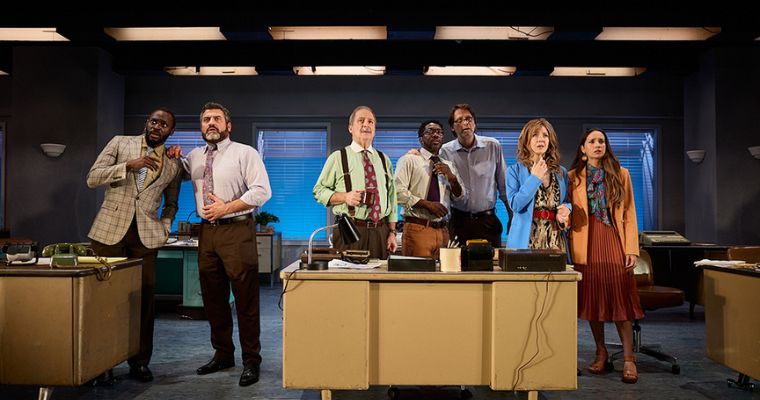
Reporters and editors watch as television coverage of the Miami riots begins in Miami New Drama's world premiere production of "Dangerous Days."
“He decorated a tree. He wrapped all his kids’ presents.”
A journalism intern notes these facts in “Dangerous Days,” a compelling historical play adaptation of the award-winning nonfiction book, “The Year of Dangerous Days,” by Nicholas Griffin.
More specifically, the intern points out that Arthur McDuffie wrapped his children’s Christmas presents at some point before he died on Dec. 17, 1979.
McDuffie, a Black former Marine, was the victim of a deadly beating by multiple white police officers in Miami following a high-speed chase in 1979. Three days of riots ensued in the city, set on fire after an all-white jury in 1980 acquitted the officers of multiple charges in connection with McDuffie’s death.
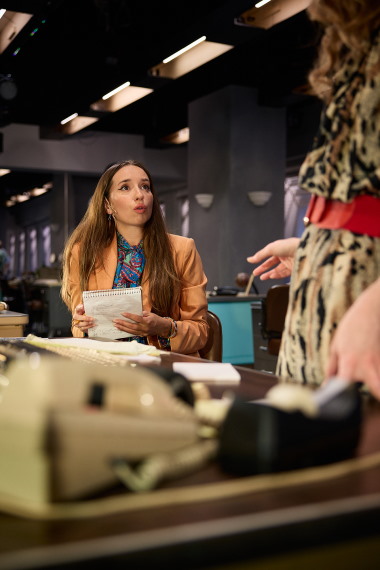
Roderick Rangle and Caitlin Clouthier are visited by a testy Rene Granado in the Miami Herald newsroom in Miami New Drama's world premiere production of "Dangerous Days." (Photo by FURIOSA Productions)
The officers claimed that McDuffie died from injuries he sustained after his motorcycle crashed. But tenacious reporting by former Miami Herald Pulitzer Prize-winning crime reporter Edna Buchanan revealed a cover-up.
Chances are, learning what McDuffie did for his children before he died will move you. It adds a human element to the true story. Fortunately, Griffin included this fact in the stage adaptation of his book. Indeed, it is one of several powerful moments in “Dangerous Days,” which is receiving a riveting world premiere professional production by Miami New Drama (MIND) through Tuesday, April 28. The performance, at the company’s home, the Colony Theatre on Miami Beach’s Lincoln Road, lasts about 95 minutes.
Kudos not only to Griffin for penning the play adaptation, but hats off to Michel Hausmann, MIND’s artistic director. He encouraged Griffin to write a play based on his book after Hausmann read and felt captivated by “The Year of Dangerous Days.” Of course, it’s a Miami story, and MIND’s mission includes making theater “that is always in conversation with our unique multicultural and multilingual community.”
MIND’s production, directed with care and flair by Jen Wineman, features a talented cast of mostly South Florida actors. They disappear into their roles and capture the high energy, fast-paced environment, and air of urgency at places such as newsrooms and police stations.
Among the seven-member cast are Cailtin Clouthier, Rene Granado, Jovon Jacobs, Roderick Randle, Caleb Scott, Stephen Trovillion, and Krystal Millie Valdes
Most of these performers portray multiple characters in the play, which takes place in the Miami Herald newsroom, as well as a police station, morgue, and other locations.
The only performers who play one role are Clouthier, a New York City-based actor who shines as Buchanan, and Randle as McDuffie. He imbues the character, who appears in the play as that individual’s ghost, with energy and an engaging personality, so we care for him. With Randle’s wide, dark eyes that convey a sense of wariness, the actor infuses McDuffie’s ghost with a sense of urgency. After all, he wants those who beat him into a coma to face consequences.
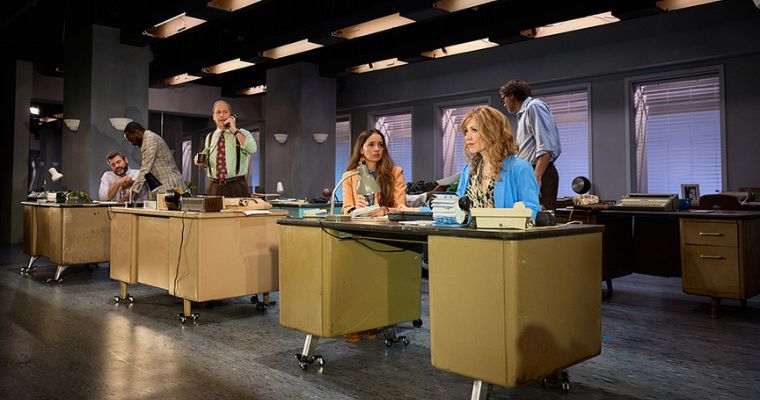
Anna (Krystal Millie Valdes) listens to Edna (Caitlin Clouthier). (Photo by FURIOSA Productions)
It took more than 40 years after McDuffie’s death for officials to place a plaque at the site where officers beat him into a coma. It’s near the corner of North Miami Avenue and N.E. 38th Street. The plaque, Griffin’s book, and now his play adaptation are other ways that McDuffie’s spirit lives on.
While Griffin is new to playwrighting, he obviously understands what keeps live theater audiences rapt. Specifically, Griffin focuses on conflict and action, sprinkles in humor, and limits narration. In addition, his writing style is lively and vivid. For instance, Buchanan tells an intern named Anna (Valdes) that her editor, Larry (Trovillion), is incompetent. “Handing him a story’s like letting your daughter date (serial killer) Ted Bundy,” the journalist says.
Griffin grabs our attention from the beginning. Specifically, we hear morning sounds such as birds twittering. “That’s morning for you,” Buchanan tells us. Then, suddenly, we hear three loud gunshots. “And that’s morning for me,” the journalist says. “I’ve got three police scanners; house, car, and work. I’m a journalist. I’m not there. But if I’m quick, I can almost be there. I can be there before the police. I’ve got two pant suits hanging by the door, never got less than half a tank in the Camero, and I know the city better than any cab driver. When I get to a scene, I can’t tell you what happened right away, but I can piece it together.”
The play’s opening is effective for a couple of reasons: first, it gives us a behind-the-scenes look at the work of a journalist. Also, it establishes Buchanan’s personality. Specifically, as Griffin depicts her, she is confident, charismatic, driven, wisecracking, and relentless. To her credit, Clouthier deftly conveys these traits without making Buchanan seem arrogant. The performer also lends Buchanan vulnerability, which enhances her humanity. Certainly, Clouthier commands the stage in the role, and demonstrates impressive naturalism.
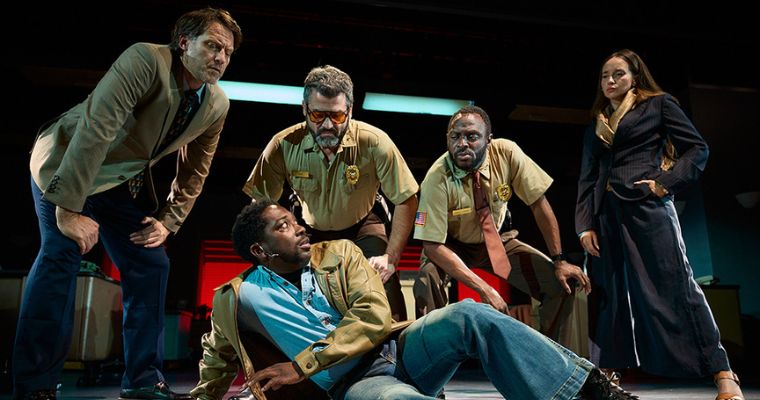
a scene from Miami New Drama's "Dangerous Days." (Photo by FURIOSA Productions)
Griffin’s play focuses on more than one conflict, and that is another reason why the piece grips us. In particular, Buchanan had developed a close rapport with officers during her time covering the crime beat. But with the McDuffie case, Buchanan becomes the individual who exposes the officers’ wrongdoing. She can’t escape them, and at least once, they express their anger at her.
Also, Buchanan’s heavy workload challenges her. She not only has to cover McDuffie, but other murders that happen in Miami as well (she has sworn to follow every murder in town.
However, during the time that Griffin has set the play, the city’s murder rate has tripled in two years.
As though that were not enough, Fidel Castro sends 125,000 refugees to Miami, including Cuba’s prison population. In addition, Colombia exports cocaine and violence to Miami.
Can one person, however talented and dedicated, handle all that? Fortunately for Buchanan, an intern is present to help her. But the intern, Anna, whom Valdes portrays with an air of eagerness and naivete, may not be who she claims to be. A plot twist revealing the truth is part of the script.
Meanwhile, a wide-eyed Jacobs portrays Bobby, a public information officer with the city’s police department. He knew McDuffie from their high school days and their time together in the military.
“Tomorrow, the brass is going to ask you to stand there in front of the press and defend a bunch of officers who might have beaten your friend to death,” Buchanan tells Bobby.
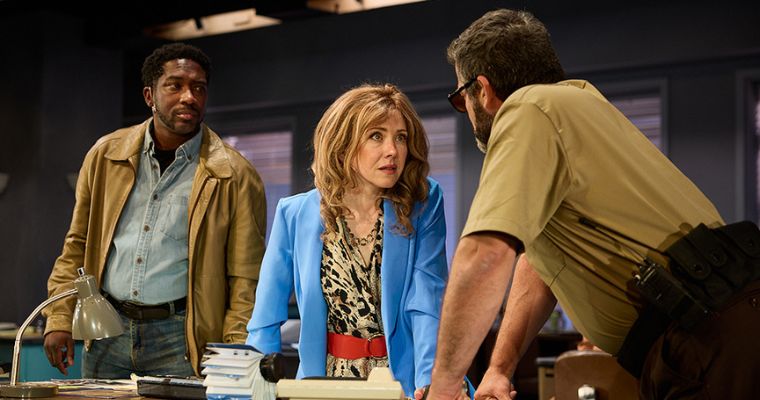
From left, Caleb Scott, Rene Granado, Jovon Jacobs, and Krystal Millie Valdes surround Arthur McDuffie (Roderick Randle). (Photo by FURIOSA Productions)
As Jacobs winningly portrays Bobby, we sense that he is torn during such moments. In addition, Jacobs’ Bobby is appropriately reassuring and kind to his late friend.
Under Wiseman’s solid direction, a near constant air of tension grips the proceedings. And Maria Yokoyama’s realistic lighting enhances the drama. In addition, the designer bathes the stage, appropriately, in red toward the end of the play, suggesting a city on fire.
Celeste Jennings designed the period costumes, while Bailey Trierweiler and UptownWorks handled the sound design, which includes realistic-sounding noises.
Tim Mackabee designed the realistic set, which depicts not only the Miami Herald newsroom, but locales such as a fast-food restaurant and police station. Props such as typewriters and rotary phones help place us in the late 1970s/early 1980s. With small adjustments, one location turns into another.
If there’s a weakness with the set design, it’s one of omission. Differentiating the Herald’s newsroom from others would have benefited the production. Perhaps a decoration or something suggesting that we’re in Miami would have sufficed.
Also, the play could provide more information about Buchanan’s life as a girl and young woman. Why did she choose to become a journalist? Were any of her family members in this field? What is her secret to success? How does she manage to multitask?
Overall, though, MIND’s production shines and makes a strong case for a long theatrical life for “Dangerous Days.” The piece has enough universal appeal to move audiences, even if theaters outside of Miami decide to stage it.
IF YOU GO
WHAT: The world premiere production of “Dangerous Days,” Nicholas Griffin’s stage adaptation of his book with a similar title.
WHEN: Through April 28. Performances are at 8 p.m. Thursday, Friday, and Saturday, as well as 3 p.m. Sunday.
WHERE: Colony Theatre, 1040 Lincoln Road in Miami Beach.
TICKETS: $46.50, $66.50, $76.50, $83.50.
INFORMATION: To buy tickets, or for other information, go to www.miaminewdrama.org, or call (305) 674-1040.




